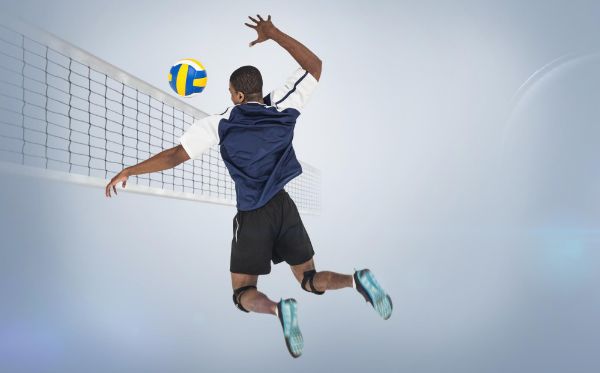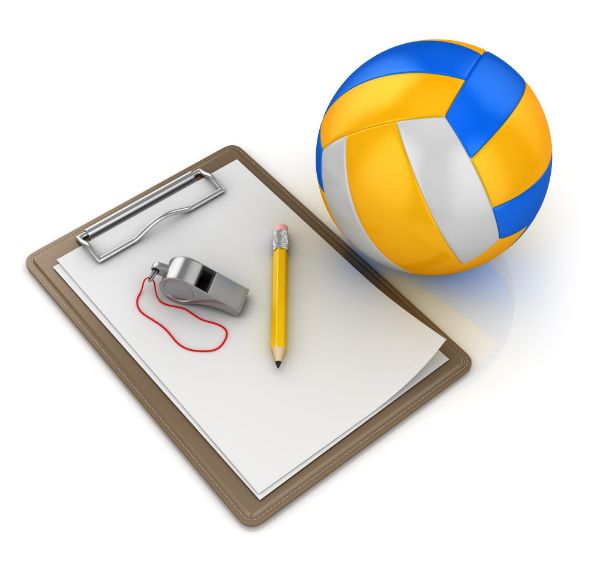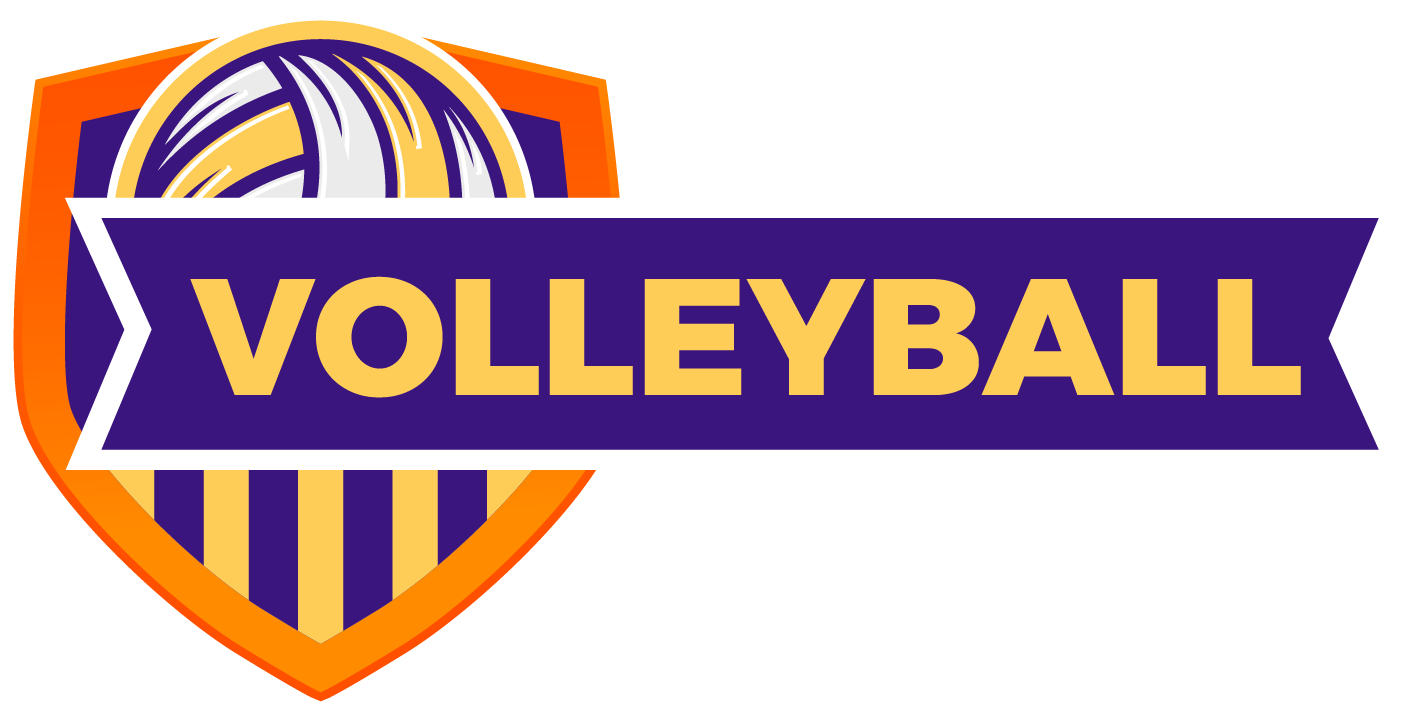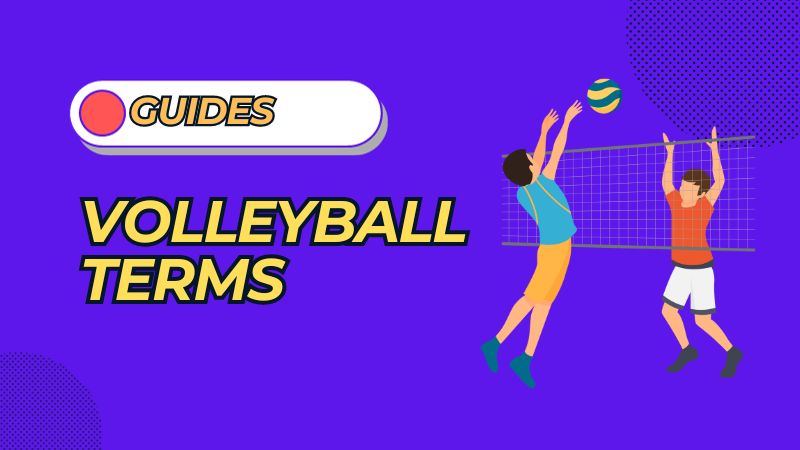As a seasoned volleyball coach and player, I’ve understand how crucial understanding volleyball terms and jargon is for being a good player. It’s perfectly okay if you don’t know every single term right off the bat. In fact, most players pick up these terms gradually through experience and practice.

In this guide, I aim to share a comprehensive glossary of volleyball terms that will help you effectively communicate and improve your game regardless of your player experience.
Volleyball Terms You Should Know

In volleyball, every term has its specific importance and role in the game. Here’s an alphabetical cheat sheet of essential volleyball terms you should be familiar with, along with their meanings:
- ACE: This is a serve that results directly in a point, typically because it’s unreturnable by the opposing team.
- ANTENNA: The white and red vertical rods are located at the net edges, above the sidelines. They mark the boundary for a legal play and are crucial for determining if a ball is in or out of play.
- APPROACH: Refers to a spiker’s rapid stride toward the net just before jumping to hit the ball. It’s a critical part of an attacking team’s strategy.
- ASSIST: This term is used when a player sets the ball for a teammate’s attack. Assists are a key statistic in professional and academic volleyball team performance.
- ATTACK: The act of offensively hitting the ball, to land it on the opponent’s court to score.
- ATTACK BLOCK: A defensive move to obstruct or block a spike before it crosses over the net.
- ATTACK ERROR: A failed attack that leads to a point for the opposing team. This can happen due to the ball going out-of-bounds, net contact, a blocked ball resulting in an opponent’s point, center line violation, or illegal contact.
- ATTACKER: A player who executes an offensive hit, aiming to end the play in their team’s favor.
- ATTACK LINE: Also known as the “10-foot line,” this line is 3 meters from the net and delineates front and back row players.
- BACKCOURT: The area between the end line and attack line, is predominantly occupied by back-row players.
- BACKSET: A set that is delivered behind the setter to an attacker, often catching the defensive team off-guard.
- BACK ROW ATTACK: An attack executed by a back row player who leaps from behind the 3m line. It’s considered illegal if they step on or past this line during take-off.
- BEACH DIG: A term used in beach volleyball for an open-hand reception of the ball, also known as “Deep Dish.”
- BLOCK: A fundamental defensive action performed by one or more players to deflect a spiked ball using their hands.
- BUMP: The basic forearm passing technique.
- BALL HANDLING ERROR: A fault that’s called for double hits, thrown balls, or lifts. This term includes blocking errors like net violations and is crucial in maintaining the game’s integrity.
- BUMP PASS: This involves using joined forearms for underhand passing or setting, a fundamental skill, especially for the defensive team.
- CAMPFIRE: A somewhat humorous term for a ball landing in a group of players, who fail to react, resembling people around a campfire.
- CENTER LINE: The line under the net dividing the court into halves. Crossing this line during play can lead to a foul.
- CLOSING THE BLOCK: The assisting blocker’s role in forming a solid block alongside the main blocker, ensures no gaps for the spiked ball to penetrate.
- CROSS COURT SHOT: An attack strategy where a player hits the ball at an angle from one end of the net to the opposite sideline.
- CUT SHOT: A sharply angled spike, usually executed from the strong side, often catching the opposing team’s defensive play off-guard.
- DECOY: A strategic play used to disguise the intended spiker, often leading to a rapidly hit ball by another player.
- DEEP SET: A set aimed further away from the net to confuse the opposing blockers and create attacking opportunities.
- DIG: The act of passing a fast, spiked ball, especially when the ball is close to the floor. It’s a crucial part of a defensive player’s skill set.
- DINK: A legal, gentle push of the ball over the blockers, often used as a deceptive offensive play.
- DOUBLE BLOCK: When two players join forces at the net to deflect a spiked ball, increasing the effectiveness of the block.
- DOUBLE HIT: Successive contact with the ball by the same player. This is deemed illegal and results in a point for the opposing team.
- DOUBLE QUICK: A play where two hitters approach simultaneously for a quick hit inside, adding complexity to the offensive team’s strategy.
- DOUBLES: A game format with two players per side, commonly seen in beach volleyball.
- DOWN BALL: A non-aggressive, overhand hit that is typically not blocked, often used by the attacking team as a safer play option.
- FIVE-ONE: An offensive formation with five hitters and one setter, a common strategy in competitive volleyball.
- FIVE SET: A specific back set to the right front hitter, part of various strategic plays in a volleyball game.
- FLARE: A move by an outside spiker who makes an inside-out movement, often hidden behind a quick hitter to confuse the opposing team.
- FLOATER: A serve that moves erratically and lacks spin, making it difficult for the receiving team to predict and control.
- FOREARM PASS: A basic technique where the ball is struck with the forearms in an underhand motion, essential for defensive plays.
- FOUL: Any violation of the rules, resulting in a point for the other team.
- FOUR SET: A set directed near the sideline, typically 1′ to 2′ above the net, used to set up an attack.
- FOUR-TWO: An offensive strategy with four hitters and two setters, offering a balance between offensive power and setting flexibility.
- FREE BALL: A pass rather than a spike, signaling the defensive team to prepare for a serve receive and often considered an opportunity for the serving team to set up a strong attack.
- HELD BALL: A fault where the ball momentarily rests in a player’s hands, resulting in a foul and a point for the opposing team.
- HIT: A forceful, overhand strike of the ball, typically used in offensive plays to challenge the defensive team.
- HITTER: A player responsible for executing attacks, crucial in the offensive team’s strategy.
- HITTING PERCENTAGE: A statistical measure representing successful kills against total attempts, indicating a player’s or team’s efficiency.
- INSIDE SHOOT: A quick, inside set play designed to outmaneuver the defense.
- ISOLATION PLAY: A strategic move to target and exploit a specific defender’s weakness, often used by the offensive team.
- JUNGLE BALL: A non-technical, often recreational form of volleyball without strict adherence to rules.
- JUMP SERVE: A serve where the player initiates with a toss, followed by a jump and a forceful downward strike, common in high-level volleyball games.
- JOUST: When opposing players simultaneously contact the ball above the net, often leading to a thrilling moment in the game.
- KEY: The skill of predicting plays by observing patterns, valuable for both offensive and defensive strategies.
- KILL: An attack that results in a direct point or side out, a key metric in evaluating a player’s offensive impact.
- LINE: The boundary markers of the court, essential for determining in and out balls.
- LINE SHOT: A spike executed along the opponent’s sideline, often used to bypass blockers.
- LET SERVE: A serve that contacts the net but remains playable, a rule that adds unpredictability to the serving team’s strategy.
- MIDDLE-BACK: A defensive position focused on covering deep spikes, usually positioned in the middle-back area of the court.
- MIDDLE BLOCKER: The front row middle player, primarily responsible for blocking close-net spikes.
- MIDDLE UP: The back row middle player, assigned to cover dinks and short shots.
- MINTONETTE: The original name given to volleyball by its creator, William G. Morgan.
- MONUMENT VALLEY: A term humorously describing the space between two tall, non-defending players.
- MULTIPLE OFFENSE: An offensive strategy utilizing a variety of set plays.
- NET VIOLATION: A fault occurring when a part of a player’s uniform or body illegally contacts the net.
- OFF-SPEED HIT: A spike executed with less power but more spin, often used to deceive the defensive team.
- OFFSIDE BLOCK: A block performed by the net player on the opposite side of the attacker.
- OUTSIDE HITTER: A key attacker positioned on the right or left front, who approaches the ball from the outside.
- OVERHAND PASS: A pass made using open hands from above the forehead, a fundamental skill in volleyball.
- OVERHAND SERVE: Serving the ball with the palm of the hand above the shoulder, a common serve in competitive play.
- OVERLAP: Refers to the rotation positions of players before the serve, crucial for maintaining the game’s order.
- PAINT BRUSH: A failed spike attempt where the player only brushes the ball lightly.
- PANCAKE: A defensive move where a player dives and uses the back of their hand to keep the ball from touching the floor.
- PASS: Often referred to as the forearm pass; a basic technique using the forearms connected at the wrists to control the ball.
- PENETRATION: A blocking technique where the player reaches across and breaks the plane of the net, effectively blocking the ball.
- PEPPER: A drill involving two players who pass, set, and spike the ball to each other, a fundamental warm-up exercise in volleyball.
- POINT OF SERVICE: Refers to a successful serve that results in a point, commonly known as an “ace”.
- POWER ALLEY: Describes a powerful hit that travels diagonally across the court, often difficult to defend.
- POWER TIP: A strategic, powerful push or control of the ball by the attackers, used to outsmart the defense.
- POWER VOLLEYBALL: A competitive style of volleyball, originally developed by the Japanese, emphasizing speed and power.
- PRINCE: A term humorously referring to a player who always hits the ball with maximum power, often with little strategic consideration.
- QUICK SET: An above-the-net set play where the hitter anticipates the setter’s action and is in the air before the ball is set.
- RAINBOW: A high, arc-shaped shot, typically used to send the ball over the opposing team’s players in a strategic manner.
- READY POSITION: The neutral and alert stance a player adopts before engaging in a play. It’s crucial for both defensive and offensive readiness.
- RECEPTION ERROR: This occurs when a player fails to properly receive and return a serve or attack, often resulting in an immediate point for the serving team.
- RED CARD: Issued by an official after two yellow card warnings, leading to a player’s or team’s disqualification from the game.
- REDWOOD: A humorous term for a tall, somewhat uncoordinated blocker, often challenging for the attacking team to navigate.
- ROLL: A technique for returning a ball close to the floor, where the player rolls it over their arms, back, or shoulders, crucial in defensive play.
- ROOF: A spike block that effectively deflects the ball straight to the floor, a dominant move in the defensive system.
- ROTATION: The clockwise movement of players around the court after a side out, crucial for maintaining the integrity of the game’s structure.
- SCREENING: An illegal move where a player obstructs an opposing server’s field of vision, often leading to a foul.
- SERVE: The action of putting the ball into play at the start of a rally, critical in both offensive and defensive strategies.
- SERVER: The player who initiates the serve, playing a key role in the serving team’s strategy.
- SERVICE ACE: A serve that results directly in a point, typically due to being unreturnable by the receiving team.
- SERVICE ERROR: A failed serve resulting in a point for the opposing team, often a critical moment in the volleyball game.
- SERVICE WINNER: A point earned by the serving team immediately after serving the ball, an important aspect of the serving team’s offensive play.
- SET: Strategic passes among players intended to direct the ball to a spike, a key element in setting up an attack.
- SETTER: The player who performs the second of three passes, setting the ball up for a hitter, central to the offensive team’s strategy.
- SHANK: An extremely botched pass, often resulting in a point for the other team or a loss of momentum.
- SIDE OUT: Occurs when the receiving team is given the serve due to an error by the serving team, a pivotal moment in the volleyball game.
- SIX-PACK: A spiked ball that hits the blocker in the face or head, often considered an aggressive offensive play.
- SIX-TWO: An offensive strategy using six players and two setters in rotation, providing flexibility and variety in the attacking team’s approach.
- SIZZLE THE PITS: A spike that passes close by players’ raised arms, a skillful move in an offensive team’s arsenal.
- SKY BALL: An underhand serve that sends the ball high over the net and straight down, a unique serving style often seen in beach volleyball.
- SPIKE: A forceful hit intended to score by landing the ball on the opponent’s court, a fundamental part of the attacking team’s strategy.
- STRONG SIDE: The preferred hitting side for a player, typically the left front row for a right-handed hitter, and vice versa.
- STUFF: Slang for a successful block where the ball is deflected back to the attacker’s court, a critical component of the defensive team’s strategy.
- TANDEM: A play intended to surprise blockers, where one player attacks directly behind another, an innovative move in the offensive team’s playbook.
- TIP: Control of the ball with the fingers, used to deceive blockers, a subtle yet effective offensive move.
- TOOL: A hit that intentionally bounces off a blocker’s arms and out of bounds, a strategic play in the offensive team’s toolkit.
- TRAP SET: A low, tight set close to the net, often challenging for hitters but can be effective in catching the opposing team off guard.
- TUNA: A humorous term for a net violation, indicating a player’s accidental contact with the net, often leading to a point for the other team.
- TURNING IN: A technique where the outside blocker turns their body toward the court to deflect the ball inbounds, a key move in the defensive team’s strategy.
- UNDERHAND SERVE: A serving style where the ball is lightly tossed into the air and struck with a closed fist, a basic yet effective serve.
- WEAK SIDE: The opposite of the strong side, typically the right front side for a right-handed player, and vice versa, often exploited by the attacking team.
- WHALE: A funny term for a player who swings at the ball with great power but little strategic thought, often leading to unpredictable plays.
- WIPE: Also known as a “tool”, a deliberate hit of the ball off a blocker’s arms and out of bounds, a cunning move in an attacker’s repertoire.
- YELLOW CARD: A warning of misconduct issued by an official to a player, with two yellow cards leading to a red card and potential disqualification from the game.

Conclusion
I hope that today’s guide clarified some key volleyball terms for you like the strategic ‘wipe’ and the fundamental ‘bump’. It’s completely normal if you can’t recall every single term right away. Volleyball, like any sport, is a journey of continual learning and improvement. This guide is here for you to refer back to whenever you need to freshen up your knowledge.
A good volleyball player is not just defined by their skills on the court, but also by their dedication to understanding the game. Keep researching, keep practicing, and most importantly, keep enjoying the game!

